Zetta Elliott's Blog, page 88
June 8, 2011
meeting stars in bad shoes
Today I was on the train reading The Wonder, Diana Evans' latest novel, when I suddenly had a memory of my father. When I first came to visit him in Brooklyn in 1993, he got a bit salty whenever I wanted him to take me someplace. I found out that Maya Angelou was giving a talk in Manhattan and decided to go; I put on my best dress, which had been a gift from friends, but didn't have any shoes to wear with it. I asked my stepmother to show me how to pin up my hair the way she did hers, and she did it but muttered under her breath the whole time. Finally I slipped on some crappy second hand shoes that my older sister would've thrown away if I hadn't rescued them from the trash. I headed for the front door and told my father I'd be home by midnight. My stepmother glared at him, he started muttering too, but finally got up off the couch and drove me downtown.
I don't actually remember what Maya Angelou said that night; I just remember being embarrassed about my shoes and feeling woefully underdressed. I remember a white mother and her two biracial daughters smiling at me, and how my eyes immediately went to the floor because I just knew they felt sorry for me with my hand-me-downs and hastily done hair. Then all of a sudden my father perked up—"That's Cicely Tyson!" he exclaimed, and next thing I knew he was dragging me down the aisle. "She's from Nevis," he whispered, and I remember thinking, "Yeah, right." But I let myself be led over to Cicely Tyson, who was elegantly dressed in a black dress and oversized hat. And then the crowd around her thinned a bit and my father stepped forward—and bowed. He actually bowed. And he said something about being from Nevis as well, and then he reached back his hand but I was just out of reach, and so he had to turn back and beckon me forward. "May I present my daughter," he said in this ridiculously formal voice, and he probably expected me to curtsy or something, but I just smiled and looked at my bad shoes. Ms. Tyson was very gracious, she called me "lovely," and then my father bowed a couple more times before I managed to pull him away.
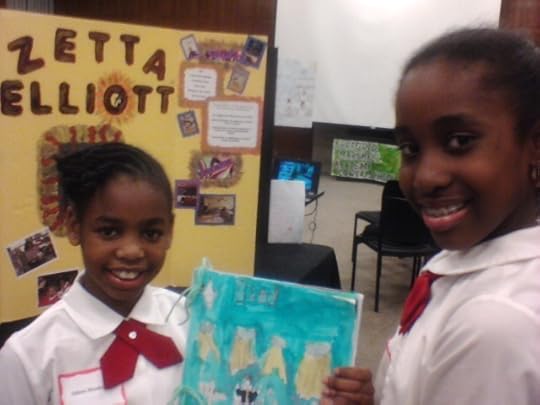 I guess I thought about that experience because The Wonder is about a young Jamaican boy who decides he wants to be a kite—then his father takes him to see Katherine Dunham's dance company, and he decides to become a dancer instead. He gets to meet Ms. Dunham and the encounter changes his life. Tonight I went up to Harlem for the Thurgood Marshall Academy Lower School's Art and Authors Night. As soon as I arrived, I saw Faith Ringgold seated at a table signing books. There was gorgeous artwork everywhere, and uniformed students would come up and offer to tell you all about the author they had studied. It was like a science fair but for books! And eventually I found the students in Ms. McDowell's 5th grade class who had interviewed me last month, and their display was amazing–two posterboards, a powerpoint slideshow, a list of *all* my publications, letters, stories with alternate endings (Mehkai changes his name to "Eric," becomes an alcoholic, but ultimately goes to rehab and becomes a doctor), innovative book covers, and tissue paper birds they had made to represent the characters in Bird—a penguin for Marcus "because he can't fly." Then the scheduled performance began, the student emcees welcomed the guests, and after Ms. Ringgold got up to say a few words, I was
I guess I thought about that experience because The Wonder is about a young Jamaican boy who decides he wants to be a kite—then his father takes him to see Katherine Dunham's dance company, and he decides to become a dancer instead. He gets to meet Ms. Dunham and the encounter changes his life. Tonight I went up to Harlem for the Thurgood Marshall Academy Lower School's Art and Authors Night. As soon as I arrived, I saw Faith Ringgold seated at a table signing books. There was gorgeous artwork everywhere, and uniformed students would come up and offer to tell you all about the author they had studied. It was like a science fair but for books! And eventually I found the students in Ms. McDowell's 5th grade class who had interviewed me last month, and their display was amazing–two posterboards, a powerpoint slideshow, a list of *all* my publications, letters, stories with alternate endings (Mehkai changes his name to "Eric," becomes an alcoholic, but ultimately goes to rehab and becomes a doctor), innovative book covers, and tissue paper birds they had made to represent the characters in Bird—a penguin for Marcus "because he can't fly." Then the scheduled performance began, the student emcees welcomed the guests, and after Ms. Ringgold got up to say a few words, I was 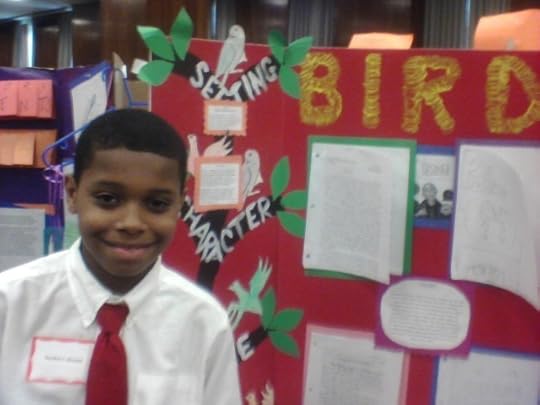 asked to do the same. Suddenly I was aware of my shoes—shabby old suede sandals that I wore because they're comfortable and I didn't want to try to look cute when it's a hundred degrees outside and the event was several blocks from the subway. Ms. Ringgold was glittery and dazzling and very bohemian—a real artiste—and I looked like a school marm b/c I try to dress safe when I know there will be parents around. Anyway, I got up there and made a few remarks that I'd already prepared…and then decided to wing it and share how I came to know about Faith Ringgold's art by studying her daughter's important scholarship in graduate school. I wrapped up, headed back to my place in the crowd, and a woman reached out to grab my hand. "You know Michele Wallace is over there, right?" And she pointed out Michele Wallace, sitting across the room. "Oh crap," I said, "I wouldn't have said that if I'd known she was here." And then the woman pulled me a bit closer and said, "And I'm her sister, Barbara."
asked to do the same. Suddenly I was aware of my shoes—shabby old suede sandals that I wore because they're comfortable and I didn't want to try to look cute when it's a hundred degrees outside and the event was several blocks from the subway. Ms. Ringgold was glittery and dazzling and very bohemian—a real artiste—and I looked like a school marm b/c I try to dress safe when I know there will be parents around. Anyway, I got up there and made a few remarks that I'd already prepared…and then decided to wing it and share how I came to know about Faith Ringgold's art by studying her daughter's important scholarship in graduate school. I wrapped up, headed back to my place in the crowd, and a woman reached out to grab my hand. "You know Michele Wallace is over there, right?" And she pointed out Michele Wallace, sitting across the room. "Oh crap," I said, "I wouldn't have said that if I'd known she was here." And then the woman pulled me a bit closer and said, "And I'm her sister, Barbara."
 The event continued, I signed a few books, and then slipped away in my shabby sandals. I did force myself to say a few words to Faith Ringgold; she told me about finishing her memoir in 1980 and having it rejected by publishers. "They think you'll stop—that's how it works. They say no, and you're supposed to give up. But I wouldn't." She later admitted that the '80s and '90s were better times for picture books, but still—I got the point. Keep writing. Don't let anyone silence you. Then a high-energy kid bopped up and asked for my autograph and Ms. Ringgold moved on. No one will ever remember me for being stylish—maybe a few will remember my ugly shoes. But it's the work you leave behind that matters. This week I've been working on a memory book for my niece, Maya. She just had her first trip to NYC and I've spent hours cutting and pasting and gluing and printing out pictures. But this morning I had to put the book out on the fire escape—it's toxic! It literally gave me a headache. I don't know WHY noxious fumes rise from the pages, but I hope I can solve this problem b/c it's a really cute book!
The event continued, I signed a few books, and then slipped away in my shabby sandals. I did force myself to say a few words to Faith Ringgold; she told me about finishing her memoir in 1980 and having it rejected by publishers. "They think you'll stop—that's how it works. They say no, and you're supposed to give up. But I wouldn't." She later admitted that the '80s and '90s were better times for picture books, but still—I got the point. Keep writing. Don't let anyone silence you. Then a high-energy kid bopped up and asked for my autograph and Ms. Ringgold moved on. No one will ever remember me for being stylish—maybe a few will remember my ugly shoes. But it's the work you leave behind that matters. This week I've been working on a memory book for my niece, Maya. She just had her first trip to NYC and I've spent hours cutting and pasting and gluing and printing out pictures. But this morning I had to put the book out on the fire escape—it's toxic! It literally gave me a headache. I don't know WHY noxious fumes rise from the pages, but I hope I can solve this problem b/c it's a really cute book!








June 7, 2011
DIPNET ~ US Edition
 Have you become a member of DIPNET yet? It's free and easy to join. You can read my guest post on their blog today and later this week I'll be interviewing Bobby Nayyar, DIPNET Consultant Development Manager, in order to better understand just how the Diversity in Publishing Equalities Charter came about and how he manages to convince publishers in the UK to tackle the issue of equity. I know that Americans generally like to think of themselves as "world leaders," and many aren't fond of the idea of following a European business model. But you know what? A good idea is a good idea, and we can learn from others without mimicking them. Look at all the amazing TV shows we've "borrowed" from the British—American Idol, Dancing with the Stars, The Office…
Have you become a member of DIPNET yet? It's free and easy to join. You can read my guest post on their blog today and later this week I'll be interviewing Bobby Nayyar, DIPNET Consultant Development Manager, in order to better understand just how the Diversity in Publishing Equalities Charter came about and how he manages to convince publishers in the UK to tackle the issue of equity. I know that Americans generally like to think of themselves as "world leaders," and many aren't fond of the idea of following a European business model. But you know what? A good idea is a good idea, and we can learn from others without mimicking them. Look at all the amazing TV shows we've "borrowed" from the British—American Idol, Dancing with the Stars, The Office…








June 4, 2011
agony & ecstasy
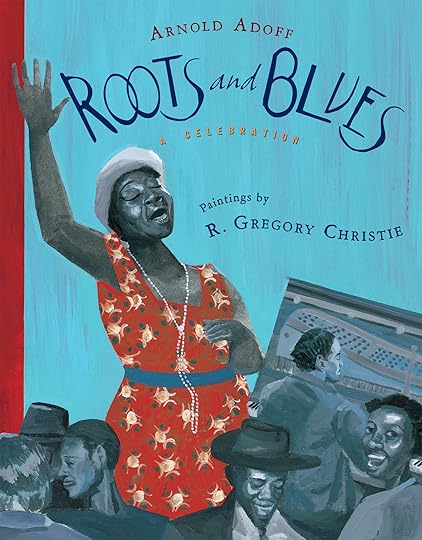 Roots & Blues, Part 2! It's been a long time coming, but I guarantee you this interview with illustrator R. Gregory Christie is worth the wait! If you missed Part 1 of this series, do take time to read poet Arnold Adoff's thoughtful responses regarding the inspiration for his latest book of poetry.
Roots & Blues, Part 2! It's been a long time coming, but I guarantee you this interview with illustrator R. Gregory Christie is worth the wait! If you missed Part 1 of this series, do take time to read poet Arnold Adoff's thoughtful responses regarding the inspiration for his latest book of poetry.
ZE: It has been argued that "trauma resists representation." How did you approach the illustrations depicting the horrors of the Middle Passage? As a children's book illustrator are you expected to make every subject "beautiful"?
It's all about nuances and the experience a painter has gained in order to shout things softly to his audience. The metaphorical poems in Roots and Blues masterfully intermixed historical names and events into a continuous flow. I feel that the words have a similar sentiment to Blues music, by the way the atrocities and triumphs are a continuous poetic flow. To paraphrase Tom Feelings, any subject matter can be presented to people of all ages, one has only to hear the blues to know something horrible can be told in a beautiful way.
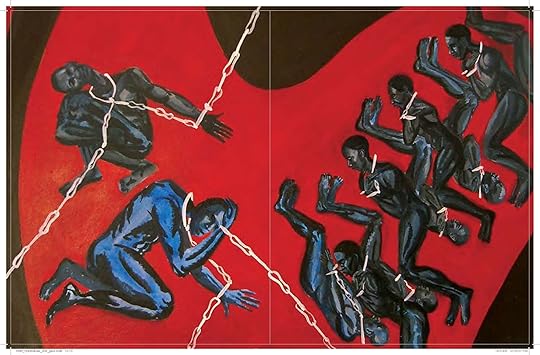 I also believe that if you present a trauma with a melody, metaphorical words, or with attractively arranged pigments you can at least get the public's attention, but it's the artist's experience and ability to use nuance that will get people to care. If done carefully, I believe that the art will be embraced as something beautiful, at least for some of the people. The poems from Roots and Blues mimicked the essence of the Blues and the history of brown folks' "American" journey. So I, in turn, mimicked Arnold's words in a visual form, which I suppose is the purpose of an illustration.
I also believe that if you present a trauma with a melody, metaphorical words, or with attractively arranged pigments you can at least get the public's attention, but it's the artist's experience and ability to use nuance that will get people to care. If done carefully, I believe that the art will be embraced as something beautiful, at least for some of the people. The poems from Roots and Blues mimicked the essence of the Blues and the history of brown folks' "American" journey. So I, in turn, mimicked Arnold's words in a visual form, which I suppose is the purpose of an illustration.
The visuals are muted grays and blues that I hope are in tandem with the dull pain to those words that were intermixed with pockets of joy. This is the first time I used a glazing technique for an entire book. I chose to knock the colors down a bit, kind of a bluish gray pallor cast over what was once vibrant colors. I was able to wipe away and rebuild certain places in the painting so that the glaze would in fact brighten certain areas within the images. This was done to have pockets of vibrant colors in cool and distant images.
Yes, I'm often expected to make my art beautiful (if not cute) but I tip the balance towards images that will challenge our children. Foremost I paint for myself and do this with the hope that other people will "get it." I keep it fun and interesting but also honor myself as an artist.
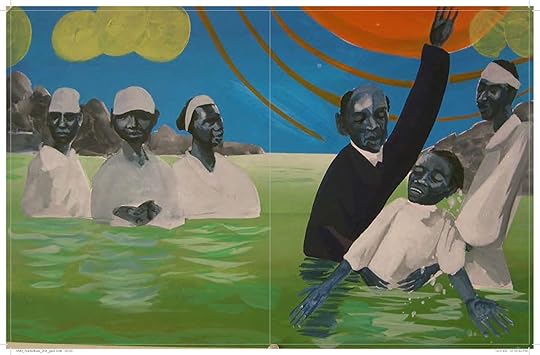 ZE: In the blues tradition there's a fine line between ecstasy and agony; talk about your strategies for capturing both emotions in your illustrations.
ZE: In the blues tradition there's a fine line between ecstasy and agony; talk about your strategies for capturing both emotions in your illustrations.
I am all about balance, in my life and in my art. The artwork for this book was my best attempt to capture Arnold's flow of opposites, colorful moments as a contrast within a long, painful journey.
He has an ability to give historical facts, capture the emotion of the times, and barrage my mind with a stream of visuals. Nothing was sugarcoated in the writing; perhaps that would be a disservice to the people that went through that pain and to the young people that need to be prepared for the world's realities. It seems to me that Arnold danced between these two conflicting emotions all the time (ecstasy and agony) while not being too nostalgic. The poems and the times they comment upon are raw. He put himself out there as an artist and I wanted to keep up with him visually.
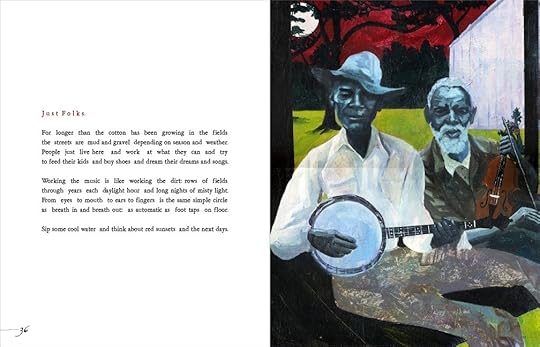 But Poetry is one of the most difficult things to illustrate for me, because you have to be decisive when interpreting the meaning of a series of meanings. I always think that such a work can be read so many different ways and too quick of a decision towards the meaning can kill the audience's growth. On the other hand, indecision in the illustrator can often produce a visual incongruity. In illustration I think the major point is to be able to process the mix into an interesting visual summation. Poetry seems to be a mix within a mix, an art form capable of having many tentacles. I think that it takes a delicate heart and advanced mind to embrace something that can be so mercurial, definitively stated and so personal to the reader. I feel as though such a listener wants to create his own relationship to those words, so being told what's definitive as the meaning (visually) can come off as a killjoy.
But Poetry is one of the most difficult things to illustrate for me, because you have to be decisive when interpreting the meaning of a series of meanings. I always think that such a work can be read so many different ways and too quick of a decision towards the meaning can kill the audience's growth. On the other hand, indecision in the illustrator can often produce a visual incongruity. In illustration I think the major point is to be able to process the mix into an interesting visual summation. Poetry seems to be a mix within a mix, an art form capable of having many tentacles. I think that it takes a delicate heart and advanced mind to embrace something that can be so mercurial, definitively stated and so personal to the reader. I feel as though such a listener wants to create his own relationship to those words, so being told what's definitive as the meaning (visually) can come off as a killjoy.
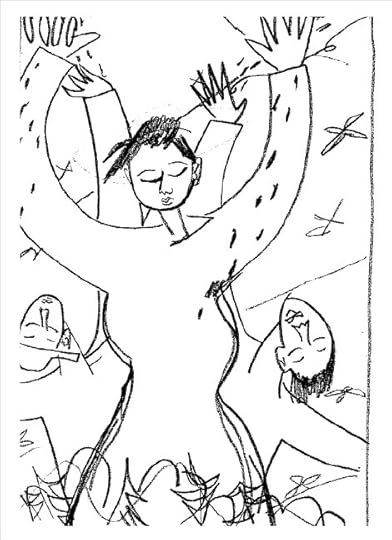 I respected his art by approaching the series of poems as one steam of ideas. In some cases I focused on the idea of something literal…a piano player or image of a jook joint etc., and other times I attempted to comment on the spiritual side of things. One of the first pieces shows three figures connecting with land and water; eyes are closed and bodies contorted. On one hand, it would have been easy to define the words near it as a piano player image, but I took the harder road and commented on the metaphorical aspect. I wanted to introduce the reader to the origins of it all: the respect for the land and the process of life, it's circular direction between death and life. We come from the earth only to go back within it, so this first painting is about impossibilities and how something that doesn't make sense sometimes has an order to it. Time must pass in order to sometimes understand that disorder. The land, people and gestures are my way of introducing the readers to what they might expect for the other parts of this book. To expect that the impossible will make sense and to take the subject matter with solemnity and inspiration. I had to pace myself and pace the imagery for the book. At times you will see the agony in the lack of facial expressions—simply eyes closed or the gesture of the hands and body—and other times the figures will be directly looking at you, engaging you as the viewer. It's art that shows itself but invites you to find your own meaning based upon your own life experiences and whatever you can project into the historical and artistic experience.
I respected his art by approaching the series of poems as one steam of ideas. In some cases I focused on the idea of something literal…a piano player or image of a jook joint etc., and other times I attempted to comment on the spiritual side of things. One of the first pieces shows three figures connecting with land and water; eyes are closed and bodies contorted. On one hand, it would have been easy to define the words near it as a piano player image, but I took the harder road and commented on the metaphorical aspect. I wanted to introduce the reader to the origins of it all: the respect for the land and the process of life, it's circular direction between death and life. We come from the earth only to go back within it, so this first painting is about impossibilities and how something that doesn't make sense sometimes has an order to it. Time must pass in order to sometimes understand that disorder. The land, people and gestures are my way of introducing the readers to what they might expect for the other parts of this book. To expect that the impossible will make sense and to take the subject matter with solemnity and inspiration. I had to pace myself and pace the imagery for the book. At times you will see the agony in the lack of facial expressions—simply eyes closed or the gesture of the hands and body—and other times the figures will be directly looking at you, engaging you as the viewer. It's art that shows itself but invites you to find your own meaning based upon your own life experiences and whatever you can project into the historical and artistic experience.








June 3, 2011
The Ethical Author
 In the summer of 2009 I got an unusual email from Amazon—not an advertisement or order confirmation, but a personal email. This message came from an acquisitions editor who had read my novel, A Wish After Midnight, which I self-published the year before. This editor said he loved the book and wanted to partner with me to help it find a larger audience. After verifying that it wasn't a hoax, I entered into negotiations and ultimately sold the rights to my novel to AmazonEncore, the company's new publishing wing. Wish was given a beautiful new cover and was re-released six months later in early 2010.
In the summer of 2009 I got an unusual email from Amazon—not an advertisement or order confirmation, but a personal email. This message came from an acquisitions editor who had read my novel, A Wish After Midnight, which I self-published the year before. This editor said he loved the book and wanted to partner with me to help it find a larger audience. After verifying that it wasn't a hoax, I entered into negotiations and ultimately sold the rights to my novel to AmazonEncore, the company's new publishing wing. Wish was given a beautiful new cover and was re-released six months later in early 2010.
As a black feminist, I definitely had reservations about partnering with a behemoth like Amazon. I worried what my friends would say—would they accuse me of selling out? Was I betraying my feminist values? Yet, I reasoned, I had spent nearly a decade dealing with rejection from big and small publishers alike. My work was even turned down by a feminist press that was headed by a black woman! I didn't embrace self-publishing at the outset—I was driven to it by the refusal of traditional publishers to give my writing their official stamp of approval. Self-publishing ensured that my work would exist in the world, but I still encountered a great deal of resistance and a certain measure of disdain, and it was a real challenge to get my books into the hands of readers and reviewers.
In the end, to my relief, most of my feminist friends congratulated me on my decision to work with Amazon and did all they could to spread the word about my "new" novel. I had a fantastic experience collaborating with the AmazonEncore team—I was treated with respect, my expertise and ideas were valued, and no changes were made to my feminist narrative about two black teenagers sent back in time to Civil War-era Brooklyn. Wish wasn't reviewed in any major outlets, but the blogosphere embraced it and my overall experience was so positive that I plan to publish my next YA novel with AmazonEncore in 2012.
I'm still determined, however, to keep all options on the table when it comes to publishing. The industry is in flux right now, and I think authors need to respond by being flexible and open to new possibilities. We also need to be conscious of the ways that certain voices continue to be marginalized within the publishing community. Statistics compiled by the Cooperative Children's Book Center demonstrate that authors of color constitute only 5% of the five thousand books published annually for young readers. Getting published is an uphill battle for most writers, but the institutional racism that pervades all sectors of US society makes it that much harder for people of color to have their stories published by traditional houses. Self-publishing has been an important option for black writers for centuries, and I suspect that won't change any time soon.
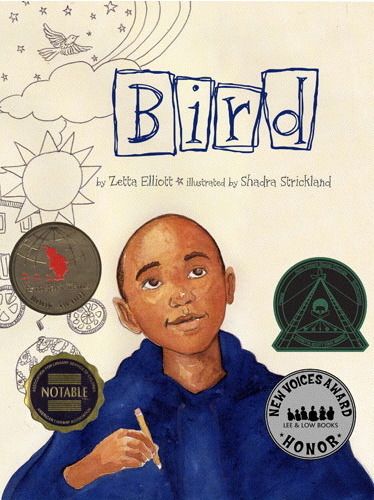 The first time I spoke publicly about self-publishing was at Rutgers University. After reviewing my award-winning picture book, Bird, Dr. Yana Rodgers invited me to speak to her students in the Women and Gender Studies Department. She assigned my self-published play, Mother Load, and I developed a presentation that paid tribute to Barbara Smith and Audre Lorde. I talked about Second Wave black feminist publications and the historical importance of Kitchen Table: Women of Color Press, founded by Smith following a 1980 phone conversation in which Lorde asserted, "We really need to do something about publishing." Nearly a decade later, Smith reflected on this pivotal moment:
The first time I spoke publicly about self-publishing was at Rutgers University. After reviewing my award-winning picture book, Bird, Dr. Yana Rodgers invited me to speak to her students in the Women and Gender Studies Department. She assigned my self-published play, Mother Load, and I developed a presentation that paid tribute to Barbara Smith and Audre Lorde. I talked about Second Wave black feminist publications and the historical importance of Kitchen Table: Women of Color Press, founded by Smith following a 1980 phone conversation in which Lorde asserted, "We really need to do something about publishing." Nearly a decade later, Smith reflected on this pivotal moment:
Why were we so strongly motivated to attempt the impossible? An early slogan of the women in print movement was "freedom of the press belongs to those who own the press." This is even truer for multiply disenfranchised women of color, who have minimal access to power, including the power of media, except what we wrest from an unwilling system. On the most basic level, Kitchen Table Press began because of our need for autonomy, our need to determine independently both the content and the conditions of our work and to control the words and images that were produced about us. As feminist and lesbian of color writers, we knew that we had no options for getting published except at the mercy or whim of others—in either commercial or alternative publishing, since both are white dominated.[i]
 To the students at Rutgers I explained my decision to start my own imprint, Rosetta Press, with its mission to publish books "that reveal, explore, and foster a black feminist vision of the world." I didn't then see any significant difference between my self-publishing project and the aims of the feminists at Kitchen Table Press. But over time I had to admit that I hadn't formed a collective, and I wasn't planning to publish anyone's work other than my own—not until I caught up on the backlog of unpublished manuscripts on my hard drive. Self-publishing is, as the term suggests, very self-centered; its appeal lies in the autonomy it provides, but that level of self-reliance is only partly in line with my understanding of feminism. I confess, I don't want to tell anyone else how or what to write, and self-publishing frees me of the need to please anyone other than myself with my writing. But do I owe the world something more than my books?
To the students at Rutgers I explained my decision to start my own imprint, Rosetta Press, with its mission to publish books "that reveal, explore, and foster a black feminist vision of the world." I didn't then see any significant difference between my self-publishing project and the aims of the feminists at Kitchen Table Press. But over time I had to admit that I hadn't formed a collective, and I wasn't planning to publish anyone's work other than my own—not until I caught up on the backlog of unpublished manuscripts on my hard drive. Self-publishing is, as the term suggests, very self-centered; its appeal lies in the autonomy it provides, but that level of self-reliance is only partly in line with my understanding of feminism. I confess, I don't want to tell anyone else how or what to write, and self-publishing frees me of the need to please anyone other than myself with my writing. But do I owe the world something more than my books?
I concluded my presentation that day by reading aloud June Jordan's prophetic words about the "difficult miracle" of being a black writer in the US:
…we have been rejected and we are frequently dismissed as "political" or "topical" or "sloganeering" and "crude" and 'insignificant" because, like Phillis Wheatley, we have persisted for freedom. We will write against South Africa and we will seldom pen a poem about wild geese flying over Prague, or grizzlies at the rain barrel under the dwarf willow trees. We will write, published or not, however we may, like Phillis Wheatley, of the terror and the hungering and the quandaries of our African lives on this North American soil. And as long as we study white literature, as long as we assimilate the English language and its implicit English values, as long as we allude and defer to gods we "neither sought nor knew," as long as we…remain the children of slavery, as long as we do not come of age and attempt, then to speak the truth of our difficult maturity in an alien place, then we will be beloved, and sheltered, and published.
But not otherwise. And yet we persist.
I've written quite extensively about racism in the publishing industry and the risks and rewards of self-publishing. When aspiring authors ask me how to deal with rejection, I tell them to persist: Keep writing. Get your work done so that when the moment arrives, you'll be ready. Study the industry and know what you're up against. You may have to adjust your expectations, and you may find yourself forming unexpected alliances. But don't surrender your voice or your vision. Stay in the game and work with others who are trying to change the rules.
Lately I've been puzzling over how to be an "ethical author" in an industry that only seems to value the bottom line. Can I preserve my autonomy and still serve the communities to which I belong? I think so. Last month the publishing industry convened in NYC for the annual BookExpo America; BEA 2012 would be the perfect opportunity to ask members of the publishing industry to sit down and get serious about equity. My goal now—in between job-hunting, self-publishing a new novel, and finishing the sequel to Wish—is to replicate the UK Publishing Equalities Charter proposed by the Diversity in Publishing Network (DIPNET):
The aim of the UK Publishing Equalities Charter is to help promote equality and diversity across UK publishing and bookselling, by driving forward change and increasing access to opportunities within the industry…
For many years the industry has spoken collectively of the need to make publishing more diverse yet has not embarked on an industry wide initiative to resolve this issue. "What is widely suspected about publishing has proven true: the industry remains an overwhelmingly white profession…"
The same can be said of the publishing industry here in the US and it's about time we did something about it. I'm not ready to start a feminist press, but I can still advocate for equity so that marginalized writers can become more visible in the literary landscape, which never has accurately reflected the composition of this country.
[i] Barbara Smith. "A Press of Our Own, Kitchen Table: Women of Color Press." FRONTIERS, Vol. X, No. 3, 13-15.








May 29, 2011
make it happen
Did you attend BookExpo America last week? Did you notice that stepping into the Javits Center was like leaving New York City—trading an incredibly diverse city for an astonishingly white world of publishing professionals? We can do something about that. I just sent an email to the Conference/Education Programming team (you can find their email addresses here). Do you know anyone else who can help us make this happen? If so, please email me or leave a comment and/or reach out to them yourself. I met with Jill from Rhapsody in Books last week and we tried to think of ways to mobilize people around the issue of equity in publishing. Should we try to get a celebrity on board? Would Bill Cosby or Queen Latifah or Alicia Keyes lend their name to this cause? What about Spike and Tonya Lee, or Jada Pinkett Smith–black celebrities who have ventured into the world of publishing? Or could we dispense with celebrities and just try to get "major players" into a room and on the record? I'm open to ideas…
Greetings. My name is Zetta Elliott and I am an author/blogger/scholar. I would like to propose a session for BEA 2012 that would address the issue of equity in publishing. BookExpo is a wonderful event, yet one can't help but notice the shocking lack of diversity at the nation's largest publishing convention (held in the nation's most diverse city).
At the London Book Fair, DIPNET (the Diversity in Publishing Network) holds an annual meeting to discuss their proposed UK Publishing Equalities Charter; I think BEA could benefit from holding a similar session in order to give publishers, booksellers, book buyers, and other members of the literary community an opportunity to strategize and share ideas around improving equity in the US publishing industry. Representatives from the AAP, ABA, and AAR could join authors, educators, and librarians to set concrete goals that would ensure that the 21st-century publishing industry accurately reflects this nation of readers and writers.
I will be presenting a paper at the Race, Ethnicity, and Publishing conference at the Université de Provence in March 2012; I would like to report to attendees that the US is taking steps to address the appalling inequity in its publishing industry. I regularly blog about this issue and would be happy to collaborate with you, should you need any help coordinating and/or advertising a session for BEA 2012.
Thank you for your time and consideration.
Zetta Elliott








May 27, 2011
driven
This has been a difficult week: BEA was mostly a bust, I suffered a serious wardrobe malfunction (curse you, cute shoes!), and got a harsh reality check regarding my job prospects. Still, things ended on a positive note yesterday—my students wowed me with their artwork/performances and I got to connect with some AmazonEncore friends. Today I'm taking it easy, ignoring the stack of grading and the mound of laundry silently glaring at me from the corner. I found this interesting article on the Ms. blog: "Where Are the Girls in Children's Literature?" The conversation in recent years has focused on the neglect of boys in kidlit (or YA lit, more specifically), yet this study shows that in the last century, girls suffered from "symbolic annihilation" due to the gender disparity in children's picture books. Last week I was thinking about Elizabeth Bluemle's search for "non-race-driven" multicultural books—what would it mean (or how would I feel) if a man asked for "non-gender-driven" books about girls? Books where gender is taken for granted, and doesn't become the focus of the story? How many books would make that list?
I've been asked to contribute to an anthology about bullying and other forms of oppression, and I'm trying to convert one of my short plays into a short story. It's about two teens held in protective custody: one was rescued from a suburban brothel and the other ran away from a polygamist cult. It's definitely a gender-driven narrative, but I don't suppose anyone would have a problem with that. No one would ask for more stories about girls "just having fun" and being "ordinary people." Next on my reading list? This Vanity Fair article about sex trafficking in the US and another article from the Ms. blog about a young woman brutalized by her pimp and fellow sex workers:
When a young woman in Atlanta tried to escape her pimp in April 2010, his retaliation was swift and brutal. He ordered four other sex workers to beat the runaway until her eyes swelled shut and a bottle pierced her head.
Then the pimp locked the 21-year-old woman in a 3-by-5 foot dog cage overnight, bragging about her debasement by texting photos of the caged woman to other pimps. Police, tipped off by someone horrified by the photos, found the woman alive in a hotel and arrested the pimp and prostitutes.
Sometimes girls "just wanna have fun," and sometimes that's not remotely possible. Here's to "keepin' it real," whether you're writing about race, gender, or talking back to Beyonce (who's also featured in a new trailer for the film, Dark Girls).








May 23, 2011
kids count–and read!
 It's BookExpo this week, and I must admit that I woke with a feeling of dread this morning. I'm looking forward to meeting some new people (including Jill from Rhapsody in Books!) but I hate crowds, I'm not good at mingling, I still have to teach, and it's raining right now. Hopefully I'll be able to snag a cab so I won't have to schlep all the way out to the west side.
It's BookExpo this week, and I must admit that I woke with a feeling of dread this morning. I'm looking forward to meeting some new people (including Jill from Rhapsody in Books!) but I hate crowds, I'm not good at mingling, I still have to teach, and it's raining right now. Hopefully I'll be able to snag a cab so I won't have to schlep all the way out to the west side.
While BookExpo celebrates all things related to publishing, it's easy to forget that young readers are part of the equation. If you missed out on donating books to Ballou HS through the Guys Lit Wire book drive, then please consider giving to San Marcos H.S. in Santa Barbara. Click that link to get all the details about Ari's second book drive to supply deserving schools with books by and about people of color. Here are some of the titles they're hoping to receive:
Carmen: an urban adaptation of the opera by Walter Dean Myers
Fish out of Agua by Michele Carlo
Chain Reaction by Simone Elkeles (not out until August so an ARC would be awesome)
Under the Mesquite by Guadalupe Garcia McCall (Not out until October so an ARC would be awesome)
Huntress by Malinda Lo
Kira, Kira by Cynthia Kadohata
Luminous by Dawn Metcalf (releases in July but an ARC would be greatly appreciated!)
Sunrise Over Fallujah by Walter Dean Myers
Please mail the books to
San Marcos High School c/o Helen Murdoch
4750 Hollister Ave
Santa Barbara, CA 93110








May 21, 2011
don't look down
One of the things you learn as a New Yorker is how to navigate the streets safely. You need to be aware of your surroundings at all times, and you should be prepared to encounter things that are unpleasant and/or unexpected. At least once a week I find myself stepping around a pool of vomit—sometimes it's on the subway stairs, sometimes on the train itself. I've learned to keep moving: watch where you step, but don't linger. Closer inspection will only make the sight and smell of it that much worse.
On Wednesday a friend and I went to see Jumping the Broom. It was pouring rain when we left the theater and so we didn't conduct our usual post-film analysis over dinner, but here's a hint: before the film even ended, Rosa turned to me and said, "Ready to go?" Staying an extra ten minutes didn't do anything to improve my overall impression of this film. The next morning I woke up thinking that blogging about Jumping the Broom was a lot like looking too closely at vomit on the street. It's a mess. You know it's a mess. So don't waste time trying to analyze the mess. It's not YOUR mess, so don't waste time trying to tidy it up. Leave it alone.
 Rosa and I met up again yesterday to see the Elizabeth Catlett exhibit at the Bronx Museum. Every so often we'd find ourselves recalling yet another problematic aspect of Jumping the Broom. Why did the African American groom work for Goldman Sachs, the firm that played a significant role in the current economic crisis? Why did the ditzy light-light-light-skinned bride wear a bra and panties or skintight clothes the entire film–and why was there no evidence of the 500K her parents supposedly spent on her education (or her high-powered job in China)? Why were the dark-skinned women totally effed up—terse and frigid if she's rich (Angela Bassett) or coarse and mouthy if she's working class (Loretta Devine)? Why were there so many gratuitous bikini shots? Why was the chef digging for clams onshore in hip-waders and no shirt? Why do black women actors allow themselves to be cast in these roles? Why did I pay $9.50 for that crap when I didn't get off my behind to go see recent indie films like I Will Follow and Night Catches Us? That's really the only question that matters.
Rosa and I met up again yesterday to see the Elizabeth Catlett exhibit at the Bronx Museum. Every so often we'd find ourselves recalling yet another problematic aspect of Jumping the Broom. Why did the African American groom work for Goldman Sachs, the firm that played a significant role in the current economic crisis? Why did the ditzy light-light-light-skinned bride wear a bra and panties or skintight clothes the entire film–and why was there no evidence of the 500K her parents supposedly spent on her education (or her high-powered job in China)? Why were the dark-skinned women totally effed up—terse and frigid if she's rich (Angela Bassett) or coarse and mouthy if she's working class (Loretta Devine)? Why were there so many gratuitous bikini shots? Why was the chef digging for clams onshore in hip-waders and no shirt? Why do black women actors allow themselves to be cast in these roles? Why did I pay $9.50 for that crap when I didn't get off my behind to go see recent indie films like I Will Follow and Night Catches Us? That's really the only question that matters.
The art of Elizabeth Catlett is stunning. And I'm reading an interesting novel, Ancestor Stones, by Aminatta Forna. And on Wednesday I was interviewed by a class of 5th graders at Thurgood Marhsall Academy Lower School—SO bright and inquisitive and thoughtful. My student guide, Jaden, informed me that he plans to become a writer and is interested in this guy named Tolkien…all of which is to say, "Don't look down. Look UP!"








May 16, 2011
another new blog
"Be your own example." That's what my friend Gabrielle told me to do when I started complaining about not having any 30-something black feminist role models a few years ago. It would be so much easier if you could just point at someone and say, "I want a life like hers," but every woman has her own ambition and her own path to follow—I'm still searching for mine. I named Rosetta Press after my paternal grandmother; I bear her name and yet know very little about her. Last month I was giving advice to a young writer on redesigning her blog; last night it was my turn to follow my own advice, and I scoured my apartment for colors and textures and images that represent my imprint. This is as close as I could get: a painted map of Nevis, the Caribbean island where my father was born; a photograph of my grandfather (who refused to tell me anything about Rosetta, whom he never married); the wedding photo of my aunt (who has no memories of her mother, having been raised by another couple); the two cowrie shells I found on the streets of Brooklyn; my father's passport from when he was a teen and a British subject; and my favorite piece of fabric, which is a beautiful sari my cousin brought me from Bangladesh. I took a dozen photos and couldn't decide which was best, so the header changes every time you change the page…








May 15, 2011
relive the magic
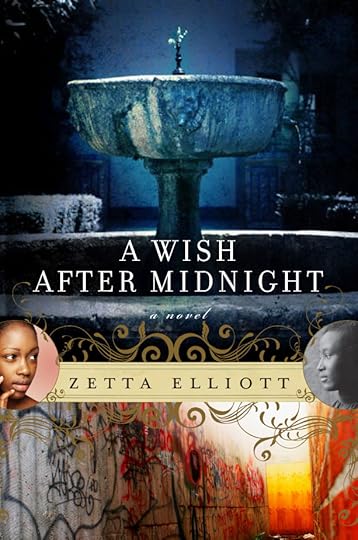 Did you miss the "Myth & Magic" reading at Franklin Park last week? The L Magazine posted this great review:
Did you miss the "Myth & Magic" reading at Franklin Park last week? The L Magazine posted this great review:
Alexi Zentner, hailed as the inventor of a new genre called "mythical realism," read passages from his novel Touch, which included a sad, riveting, macabre, and harrowing scene of an accident on a frozen river. Zetta Elliott read from her YA fantasy A Wish After Midnight, a pre-9/11 story that time-travels to Civil War-era Brooklyn; she read two passages set in the Brooklyn Botanic Garden, one sweet one in which a black-Latina girl gabs with an old Danish man, and another of ghostly, moonlit, time-folding strangeness. Elliott ended on a breathless cliffhanger that left the crowd scrambling for the merch table; during the break, everyone seemed to have a copy of her book tucked under their arms.
Thanks to for setting up shop that night!
















